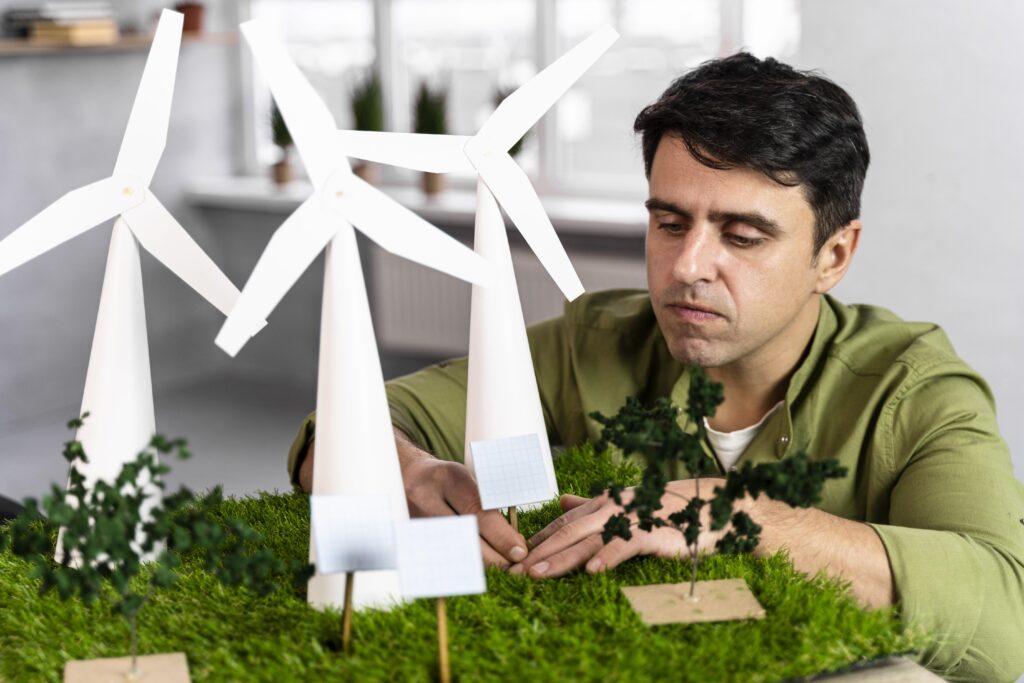Understanding what is the difference between renewable and nonrenewable resources is one of the most important lessons for our planet’s future. Every time we switch on a light, drive a car, or charge a phone, we depend on natural resources. But not all resources last forever. Some can renew naturally, while others take millions of years to form.
This article will clearly explain what makes these two resource types different, why they matter, and how they shape our environment, economy, and daily life.
Introduction to Natural Resources
Natural resources are materials that come from nature — air, water, sunlight, minerals, and fossil fuels. Humans rely on them for energy, food, and shelter. However, not all resources are created equal.
Some, like sunlight and wind, can be used again and again. Others, like coal and oil, run out once they’re used. That’s where the main difference between renewable and nonrenewable resources begins.
What Are Renewable Resources?
Renewable resources are those that can replenish naturally in a short time. These resources are continuously available due to natural cycles.
Examples include:
- Solar energy from the sun
- Wind energy from moving air
- Hydropower from flowing water
- Biomass from plants and animals
- Geothermal energy from the Earth’s heat
Because these sources renew themselves, they don’t run out easily. If used responsibly, they can support life and development for generations.
How Renewable Resources Work
Renewable resources depend on natural processes. For example:
- Sunlight keeps shining every day, powering solar panels.
- Wind moves constantly, driving turbines that generate electricity.
- Water flows through rivers and dams to create hydropower.
The key point is that these sources can regenerate quickly. Even if we use them, nature restores them without long delays.
However, to use them efficiently, we need modern technologies like wind turbines, solar panels, and dams that can convert natural energy into usable electricity.
Advantages of Renewable Resources
Renewable resources come with huge benefits for the environment and society:
- Eco-friendly: They produce little to no pollution.
- Sustainable: They never run out if managed properly.
- Cost-effective: Once set up, the running costs are low.
- Safe: They reduce greenhouse gases and slow climate change.
For example, countries like Iceland use geothermal energy for most of their electricity needs — clean, renewable, and affordable.
Limitations of Renewable Resources
Even though renewable resources are sustainable, they have some challenges:
- Solar energy depends on sunlight — no sun, no power.
- Wind turbines need steady wind to work.
- Hydropower can affect aquatic ecosystems.
This means renewable energy needs good planning, storage technology, and location-specific solutions to be reliable all year.
What Are Nonrenewable Resources?
Now let’s look at the other side of what is the difference between renewable and nonrenewable resources. Nonrenewable resources are limited. Once used, they cannot be replaced quickly — or at all — within a human lifetime.
Common examples include:
- Coal
- Petroleum (oil)
- Natural gas
- Minerals and metals like iron, copper, and gold
These resources formed millions of years ago through natural processes. Once we extract and use them, they’re gone forever.
Formation of Nonrenewable Resources
Fossil fuels like coal, oil, and gas formed from ancient plants and animals buried deep under Earth’s crust. Over millions of years, pressure and heat turned them into energy-rich substances.
That’s why they’re called fossil fuels — they come from fossils. But because this process takes so long, we cannot simply “grow” new ones when we run out.
Advantages of Nonrenewable Resources
Nonrenewable resources have powered human progress for centuries:
- High energy output: Fossil fuels produce large amounts of energy.
- Easy transportation: Oil and gas can be moved easily around the world.
- Reliable supply: They can generate power anytime, unlike solar or wind.
These qualities made nonrenewables the backbone of industrial growth and modern civilization.
Disadvantages of Nonrenewable Resources
However, there’s a heavy cost:
- Pollution: Burning fossil fuels releases carbon dioxide.
- Climate change: Greenhouse gases trap heat and raise global temperatures.
- Resource depletion: Once used up, they’re gone for good.
- Health impact: Mining and drilling can harm workers and communities.
In short, while nonrenewables built our modern world, they also created serious environmental problems.
Key Differences Between Renewable and Nonrenewable Resources
The main difference lies in availability and regeneration speed.
- Renewable resources can naturally renew.
- Nonrenewable resources take millions of years to form.
For example, if you cut a tree and plant a new one, the resource renews. But if you burn a barrel of oil, it cannot be replaced quickly.
Another big difference is environmental impact. Renewable resources are cleaner and safer for the planet, while nonrenewables release harmful gases and pollutants.
Environmental Effects of Both Resource Types
The environment reacts differently to how we use these resources. Renewable sources like solar and wind have minimal carbon emissions, helping reduce global warming.
In contrast, nonrenewables release carbon dioxide, sulfur dioxide, and nitrogen oxides — causing air pollution, acid rain, and smog.
Oil spills, coal mining, and gas drilling also damage soil and water, killing plants and animals. Shifting to renewable sources helps reduce these harmful effects.
Real-Life Examples Around the World
Countries are showing how to balance renewable and nonrenewable resources.
- Norway uses hydropower for over 90% of its electricity.
- Saudi Arabia still relies heavily on oil but is now investing in solar projects.
- China leads the world in solar panel production.
- The United States is expanding wind and solar farms while reducing coal use.
These examples show how global energy trends are changing toward cleaner, renewable options.

The Role of Technology in Energy Transition
Technology is transforming how we produce and use energy. Solar panels are becoming cheaper and more efficient. Wind turbines are now larger and more powerful.
Energy storage systems, such as lithium-ion batteries, help store renewable energy for use when sunlight or wind is low. Electric cars are replacing gas vehicles, reducing fossil fuel demand.
Meanwhile, scientists are exploring hydrogen energy and nuclear fusion — possible future sources that could be clean and limitless.
Economic Impact of Renewable vs Nonrenewable Energy
Nonrenewable resources still dominate global economies because they’ve been established for centuries. However, the renewable industry is growing fast.
According to recent energy reports, renewable energy employs over 12 million people worldwide, and this number keeps rising. Governments are offering incentives to promote green energy and reduce pollution.
On the other hand, the oil and coal industries are shrinking due to environmental regulations and market changes. Investing in renewables is becoming both economically and environmentally smart.
Government and Individual Responsibility
Governments play a huge role in managing energy resources. They can create policies that support clean energy, provide subsidies for renewable projects, and set strict pollution limits.
Individuals also make a difference — by saving electricity, using solar panels, recycling, and supporting sustainable companies. Small steps add up to big change.
Together, these efforts create a cleaner, greener world.
The Future of Energy
The future clearly leans toward renewable resources. As technology advances and awareness grows, renewable energy will likely replace most fossil fuels.
Experts predict that by 2050, more than half of global electricity will come from renewable sources. Nonrenewables will still exist but play a smaller role.
The shift won’t happen overnight, but it’s already underway — driven by necessity, innovation, and global cooperation.
Why Understanding the Difference Matters
Knowing what is the difference between renewable and nonrenewable resources helps us make smarter choices. Every decision — from what fuel we use to how we build homes — affects the planet.
Choosing renewable energy means choosing a cleaner, safer future. It means protecting the Earth for ourselves and generations yet to come.
Conclusion
In conclusion, the clear difference between renewable and nonrenewable resources lies in their ability to regenerate and their impact on the planet.
Renewable resources, such as solar and wind, can renew endlessly and support sustainable living. Nonrenewable resources, like coal and oil, are limited and cause lasting harm to the environment.
The world is moving toward renewables — a path that promises cleaner air, stable energy, and a brighter future. By understanding and acting wisely, we can protect our planet while ensuring progress continues without destruction.
FAQs
1. What are renewable resources?
Resources that can naturally replenish, like sunlight, wind, and water.
2. What are nonrenewable resources?
Limited resources like coal, oil, and natural gas that cannot be replaced quickly.
3. Why are renewable resources important?
They provide clean, endless energy and reduce pollution.
4. Can we stop using nonrenewable resources completely?
Not yet, but we can reduce their use as renewable energy grows.
5. What’s the best example of renewable energy today?
Solar energy — it’s clean, widely available, and rapidly advancing.
Read Also : Is Britannica a Reliable Source? A Complete Guide

